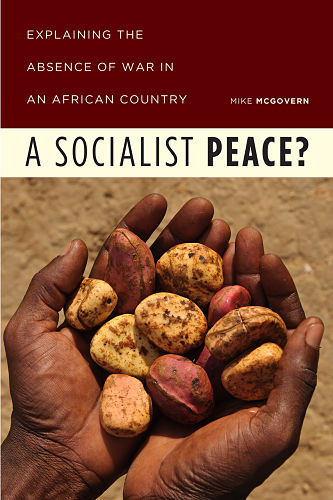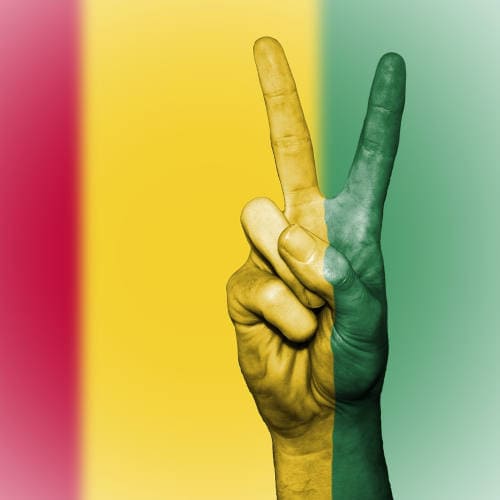In A Socialist Peace? Mike McGovern aims to explain why there was no civil war in Guinea at a time when many expected otherwise. Narrowing down on a particular time-period in 2000-2001 marked by widespread discontentment with the then government, economic instability and cross-border incursions from neighbouring states, McGovern provocatively contends that there was no war because people chose to avoid war. Focusing on communities in the Forest region and their attitudes towards ethnic groups dominating the national scene, McGovern finds that “durable dispositions” – “semireflexive orientations to the world that do not require deliberate or conscious thought” — developed in the socialist period under Sékou Touré’s regime (1959-1984), acted as the glue of the nation in this crisis.
Sékou Touré was the first President of independent Guinea who ruled the country till his death in 1984. His brand of socialism was marked by top-down policy making and planning centred around creating the pre-eminence of the national identity over other ethnic, religious or clan-based loyalties. While most Guineans hold the Touré regime with ambivalence on account of widespread state-sponsored violence, McGovern found that when faced with a crisis in 2000-2001, “both the rhetoric and practices of the socialist period” were “resuscitated” by Guineans in a variety of different ways.
A Socialist Peace? is divided into three parts over which this complex argument unfolds by making use of McGovern’s long-term ethnographic engagement primarily with Loma speakers in the Forest region of Guinea.
Part I (Chapters 2 and 3) sketches the creation of Forestière ethno-nationalism. Communities in the Forest region, as opposed to nationally dominant groups such as the Maninka/Manya and Fulbe, never lived under large-scale states before French colonisation and historically practiced African religions other than Islam or Christianity. In Chapter 2, McGovern shows how these differences interacted with nation-building projects in Guinea’s socialist era, like the Demystification program, which produced Forestières as the denigrated pre-modern others of the Guinean nation who (stereotypically) play with magic, pray to obscure gods and eat just about anything.
Further, he sketches the story of how socialist land-to-the-tiller policies disrupted the ways in which settlers (such as Maninka/ Manya) had been historically incorporated in the Forestière region by hierarchical uncle-nephew relations. In these relations, men from Forestière groups would give their sisters or daughters to settler men in marriage and, in turn, lay claim to the loyalty and support of the male child born of such unions. Touré’s land-to-the-tiller program lessened the importance of honouring such relations along with incentivising rapid population inflow to the Forest region.
Chapter 3 centres around the crystallization of the narrative of being short-changed and betrayed by the settlers among Forestière communities such as the Loma. Here, McGovern pays close attention to how different stories “became laminated together” in narratives of betrayal —like stories of the host autochthon betrayed by the guest settler, or betrayals of men by women folk— following legal interventions such as the outlawing of giving daughters in marriage against their will by the Touré regime. The processes of lamination formed a “common-sense understanding of the dangers posed by particular kinds of people” against Forestières. These processes culminated in the massacre of Manya in n’Zérékoré, the capital of the Forest region, in 1991.
Part II (Chap ter 4) is about how and why the Loma in the Forest region avoided war in a context where they had been toying with the idea of ethnically cleansing the region of the Maninka/Manya settlers. In September 2000 when Charles Taylor carried out a series of cross-border attacks into the Forest region, the “disruption of normal communications and administrative control, and a high level of ambient violence, as well as wide circulation of weapons” provided a perfect opportunity to carry out such ethnic cleansing. Though these incursions targeted United Liberation Movement of Liberia for Democracy/ Liberians United for Reconciliation and Democracy (ULIMO/LURD) rebels and refugees (primarily Maninka/Manya) who had fled to Guinea after being flushed by Taylor from the Lofa County in Liberia, Forestières suffered in these attacks as collateral damage. Further, the Loma were not friendly towards these Manya fighters and refugees as ULIMO/LURD had killed their Loma hosts and destroyed sacred forests in Lofa County back in 1996. As it became clearer that Taylor was retaliating against the Guinean state which had given the ULIMO/LURD a safe haven (and base to carry out attacks on Liberia), organisations representing Forestières and others called on the government to change their tactics in order to send the right signals to Taylor. These petitioners were brutally repressed by the Guinean state.
ter 4) is about how and why the Loma in the Forest region avoided war in a context where they had been toying with the idea of ethnically cleansing the region of the Maninka/Manya settlers. In September 2000 when Charles Taylor carried out a series of cross-border attacks into the Forest region, the “disruption of normal communications and administrative control, and a high level of ambient violence, as well as wide circulation of weapons” provided a perfect opportunity to carry out such ethnic cleansing. Though these incursions targeted United Liberation Movement of Liberia for Democracy/ Liberians United for Reconciliation and Democracy (ULIMO/LURD) rebels and refugees (primarily Maninka/Manya) who had fled to Guinea after being flushed by Taylor from the Lofa County in Liberia, Forestières suffered in these attacks as collateral damage. Further, the Loma were not friendly towards these Manya fighters and refugees as ULIMO/LURD had killed their Loma hosts and destroyed sacred forests in Lofa County back in 1996. As it became clearer that Taylor was retaliating against the Guinean state which had given the ULIMO/LURD a safe haven (and base to carry out attacks on Liberia), organisations representing Forestières and others called on the government to change their tactics in order to send the right signals to Taylor. These petitioners were brutally repressed by the Guinean state.
In this context, McGovern builds a detailed case of Forestières avoiding ethnic cleansing, or revolting against the central government, in the weeks following October 2000 when a group of Liberian Loma men came with the proposal of attacking the Manya from a few villages in the Forest region of Guinea.
In the face of such proposals stoking existing ethnic rivalries, someone in a village where these Liberian Loma men had come to seek safe passage, opposed and quashed this proposal by saying, “Here there are neither Manyas nor Loma, nor anything else: we are all Guineans.” Building his analysis from there on, McGovern documents how war and ethnic cleansing were avoided. He sketched the resuscitation of “both the rhetoric and practices of the socialist period” like the resurgence of multi-ethnic citizen militia groups which patrolled neighbourhoods and manned check points to curb the movement of such insurgents.
Part III (Chapters 5-7) grapples with the resilience of socialist structures and rhetoric as the grounds on which politics is played out and national belonging is imagined in Guinea. In Chapter 5, McGovern focuses on the same period of September-October 2000 as in Chapter 4, but moves to discuss the national scene. McGovern analyses how President Lansana Conté in the face of incursions sponsored by Charles Taylor, along with the increased mobilisation by ‘internal enemies’, took recourse to the socialist rhetoric of vigilance and directed mob violence towards refugees while continuing to protect ULIMO/LURD. At the same time, the Guinean population mounted its critique of the regime using moral categories developed during the socialist period under Touré. Chapters 6-7 deal with the general strikes of 2006-2007 in response to spectacular corruption of the Conté regime and worsening economic indicators, followed by a discussion around the death of Conté and an analysis of the successor regime of Dadis Camara (2008-2009). In doing so, McGovern works to identify some shifts in what he terms as the political “common sense” in Guinea, including the dwindling coinage of durable dispositions developed under the socialist era.
Through a very detailed study of Guinea, A Socialist Peace? engages deeply with a rich set of theoretical questions. It is, thus, a must read for scholars who are grappling with questions of conflict, resilience, social memory and the dynamics of temporality both within and outside West Africa.
This book opens up a number of windows for further research. Firstly, McGovern’s thinking around how the socialist legacy lives on in generations which did not have direct experience of living under the Touré regime encourages more work on understanding how such inheritances are transferred to and cultivated among newer generations. Secondly, it shows how historically sensitive ethnography may provide valuable inroads to studying the long-run (unexpected and perhaps non-intentional) interactions of state policies and societies. Such studies may importantly complement what is learnt from traditional policy evaluations with constrained time-frames and light-touch approaches. Thirdly, because McGovern builds his chapter on the avoidance of war (Chapter 4) by using his own experiences in Macenta Préfecture in 2000-2001 along with detailed notes from an anonymous research colleague, this book implicitly makes a case for collaborative ethnographic projects.
More experimentation and thinking are required to understand how such collaborations may be undertaken enabling ethnographers to tackle research questions over larger scales, greater complexity and time-frames. Finally, while the role of the common man or ‘the masses’ has been a focus in the study of revolutions, this is less so in studies of conflict. McGovern’s thoughts on “weak agency” and his provocations around considering the role of common folk in producing — and avoiding— wars promises an important investigative avenue for future work on peace and conflict.
Featured Image Courtesy of pixabay.com



